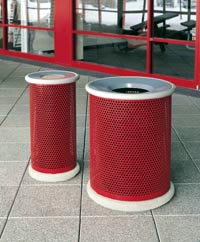A biweekly newsletter with public space news, resources, and opportunities.
A curated dispatch on all things public markets plus the latest announcements from the Market Cities Program.
Excerpted from Public Space Amenities: A Guide to their Design and Management of in Downtowns, Neighborhood Commercial Districts, and Parks, published by Project for Public Spaces.

Finding a good waste receptacle for a downtown - simple as it may sound - is not an easy task. This is, in part, because of the diverse functions that waste receptacles serve on a street. A waste receptacle, of course, should be convenient to use and easy to maintain, but it also often accommodates a wide variety of other activities. People sit on waste receptacles, rest packages or briefcases on them, meet people next to them, and so on.
One of the most common mistakes made in cities is placing waste receptacles where they are easy to empty, rather than where they are convenient for people to use. The result is often littered streets and empty waste receptacles. Because people usually will not go out of their way to find a waste receptacle, the challenge is to determine where one is needed.
To decide where a waste receptacle is needed, some simple on-site observations are necessary. The locations of existing street furniture and the type and location of ground-floor land uses (e.g., department stores, fast food, etc.) should be recorded on a large-scale map of the area. The extent, location, and type of litter should also be recorded. In addition, people such as the local sanitation workers should be interviewed about the problems they have observed. After doing these initial observations, it should be fairly clear where and how many waste receptacles are needed.

Good locations for waste receptacles are places where there are lots of people such as at busy intersections close to the crosswalks, next to take-out food shops or food vendors, at bus stops, in plazas, outside major building entrances (e.g., offices, department stores, residences), and near other street furniture such as benches or telephones.
The number of waste receptacles that are needed depends on the number of people who use an area, on the amount of litter generated by different land uses, and on the efficiency of the maintenance and sanitation program. On a downtown street, two to four waste receptacles per block is generally sufficient. One should be located at each end of the block next to the crosswalk, and one or two more in the middle of the block if there are benches or take-out food shops.

There are hundreds of different types of waste receptacles available. However, not many of them fulfill the requirements necessary to make them a good choice for a downtown street. In choosing a waste receptacle, there are several important qualities to look for.
The most important quality is that the waste receptacle looks like a place for depositing litter. All too often, in an attempt to make them blend into the environment, waste receptacles become unrecognizable as places to put rubbish. Although waste receptacles should be compatible with other street furniture and with the architectural character of the city, a waste receptacle should not ever hide its main function as a clearly recognizable place to deposit litter.
Equally important in the design of a good waste receptacle is that it is easy to use. Waste receptacles that have the following characteristics are best:
The following maintenance factors are important to consider in selecting a waste receptacle:

The New York City Department of Sanitation has recently established specifications for their new standard garbage bag that is sturdier and more resistant to puncturing and tearing than most bags. The bag is a 30-gallon polyethylene bag, 1.5 mm. thick, and costs 9 cents. However, no waste receptacle, even if it is well-designed, convenient to use, easy to empty, and properly located, will work well if it is not emptied regularly, well maintained, and moved, if necessary, to a better location. Therefore, establishing a good maintenance program and monitoring its effectiveness is an essential part of a good waste receptacle program.
There are many examples of effective and innovative programs. In Denver, responsibility for maintaining and servicing waste receptacles and other amenities on the 16th Street Mall has been contracted out to a mall management organization.
New York initiated an "adopt-a-basket" program in which private sponsors such as stores and other businesses provide maintenance and servicing of the receptacles. The sponsors also agree to clean the surrounding sidewalk.
The rich text element allows you to create and format headings, paragraphs, blockquotes, images, and video all in one place instead of having to add and format them individually. Just double-click and easily create content.
The rich text element allows you to create and format headings, paragraphs, blockquotes, images, and video all in one place instead of having to add and format them individually. Just double-click and easily create content.
Body Text Body Link
The rich text element allows you to create and format headings, paragraphs, blockquotes, images, and video all in one place instead of having to add and format them individually. Just double-click and easily create content.
Here is some highlighted text from the article.




Headings, paragraphs, blockquotes, figures, images, and figure captions can all be styled after a class is added to the rich text element using the "When inside of" nested selector system.
Headings, paragraphs, blockquotes, figures, images, and figure captions can all be styled after a class is added to the rich text element using the "When inside of" nested selector system.
Headings, paragraphs, blockquotes, figures, images, and figure captions can all be styled after a class is added to the rich text element using the "When inside of" nested selector system.